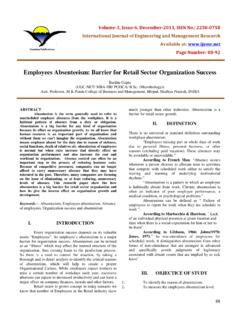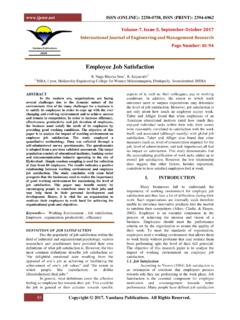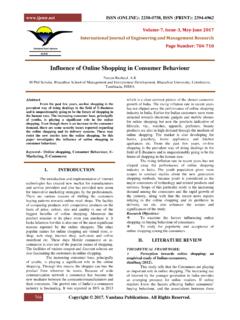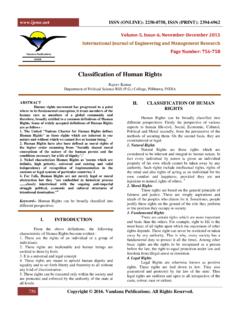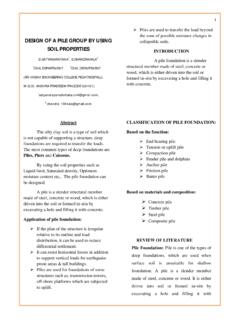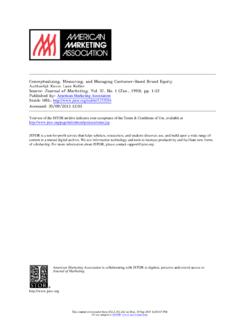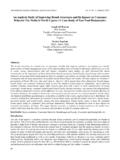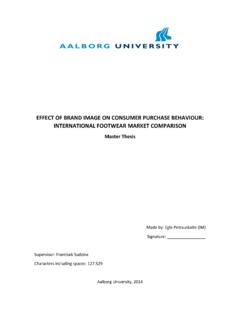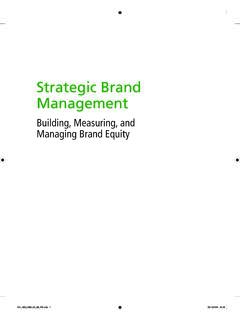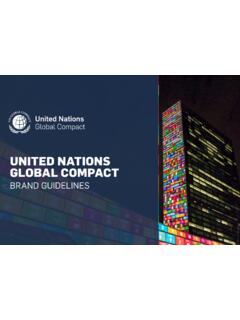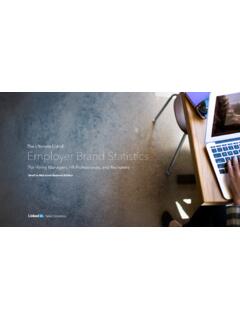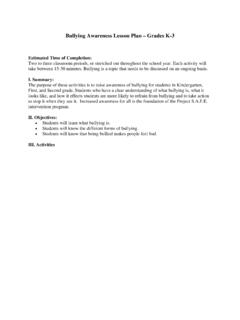Transcription of The Impact of Social Media on Brand Awareness (With ...
1 ISSN (ONLINE): 2250-0758, ISSN (PRINT): 2394-6962 262 Copyright 2017. Vandana Publications. All Rights Reserved. Volume-7, Issue-5, September-October 2017 International Journal of Engineering and Management Research Page Number: 262-272 The Impact of Social Media on Brand Awareness (With Special Reference to Facebook Use in Fast Moving Consumer Goods in Sri Lanka) Upeksha. A. S. Yapa Department of Management Sciences, Uva Wellassa University, SRI LANKA ABSTRACT Today, traditional Media is still a significant part of advertising strategies, but they cannot reach out to all members of the target audience on their own. In other hand, Social Media platforms, such as Facebook, Twitter and YouTube, also use as marketing strategy to enhance Brand communication and promote and propagate product information among consumers in an efficient manner.
2 As well as the trend of exerting Social Media platforms which FMCG industry carries out has a significant control over Brand Awareness and Brand building. Therefore, this study has endeavored to fill the gap in marketing strategies, by examining the Impact of Social Media marketing on Brand Awareness , with reference to Facebook use in fast moving consumer goods industry in Sri Lanka. The study sample was made of 200 people, both male and female, who reside in the Colombo district, use Facebook and have already liked at least one fast moving consumer goods Brand . A standardized online survey was conducted via Google Docs by employing the convenience sampling technique to collect data. The researcher has analyzed data concerning User Generated Communication and Firm Generated Communication which are main two components of Social Media marketing as the independent variables and Brand Awareness as the dependent variable to look at the correlation between these factors.
3 The results has found that User Generated Communication and Firm Generated Communication have a positive correlation and Impact with Brand Awareness . Hence, the conclusion has given as Social Media efforts positively influence Brand Awareness in FMCG industry. Thereby, the study has suggested to build platforms to enhance consumer s engagement on creating user generate contents for their brands, create and increase more Brand related and unrelated communication, combining traditional Media with Social Media , achieving company target audience through Content/Adds/Apps to be more cost effective, have excellent Brand management and good customer base. Keywords-- Firm Generate Communication, Purchase intention, User Generate Communication, Facebook I. INTRODUCTION Social Media has become an integral part of the internet and our daily lives.
4 It manifests itself in many different ways, with the term capturing a range of online platforms that are intended to facilitate global communication. Through using Social Media , everyone can create and share content among friends or globally to strangers, meaning it is now one of the greatest tools for spreading information around the world. Popular Social Media networking sites like Facebook, Instagram. Twitter, LinkedIn, and other content communities provide a platform for people to create and share content inside and outside of their professional context. This makes Social Media an invaluable tool for marketers, as it is a way for customers to share information, and for marketers to create Awareness and empowerment for a Brand to their customer base. Social networking s power becomes apparent when looking at statistics, which demonstrate that it is now a global movement.
5 Globally, the rate of those with a Social Media account is now 61%. Social networks have a faster rate of growth and usage than other online forms such as blogs and user groups (Hutton & Fosdick, 2011). Foster Research found that in 2008, 75% of Internet users were active on "Web-based Social networking" sites, such as blogs, online shopping sites or networks intended for socializing. This is up from 56% the year before. This activity included participating on Social networks, reading websites or blogs, or contributing reviews and ratings to online shopping sites (Kaplan and Haenlein, 2010). Brand Reputation is everything for a marketer. This is because if there are no other factors such as quality or price separating two brands, users will choose to purchase one over the other because of its Brand reputation.
6 Therefore, companies must differentiate and position its Brand name so that it is clear for its target market. Sometimes, visibility and recognition can be all that separate two brands. Users are now increasingly using Social Media to discuss brands and products, making reference to their functional performance as well as their Social popularity (Kotler et al, 2010). Marketers should utilize this Social power by encouraging ISSN (ONLINE): 2250-0758, ISSN (PRINT): 2394-6962 263 Copyright 2017. Vandana Publications. All Rights Reserved. consumers to engage with the Brand in a positive manner. By using web-based Social networking in a productive, well-considered way, firms have a way to create a strong online presence for themselves, and thereby be in a better position to offer believable perspectives on issues (Kotler and Keller, 2012).
7 II. RESEARCH PROBLEM Sri Lankan organizations spend around 56 billion rupees a year on traditional Media advertising (Athukorala, 2012). It is evident that Sri Lankan organizations invest significantly in both Social and traditional Media . However, it is still unclear what kind of Impact Social Media has on Brand Awareness in Sri Lanka, because the existing literature does not provide empirical evidence that is unique to Sri Lanka. To frame our understanding of Sri Lanka, other countries can be analyzed to understand the concepts. According to Balas (2014), Social Media has significantly increased Brand Awareness in Romania, while Jokinen (2015) found that Social Media can influence the overall impression of a Brand s image.
8 Factors such as using a site, the engagement of it, and the experience of users, related associations and a user s Awareness of a Brand all have a positive Impact on the Brand image (Nikolova 2012). Additionally, Maria (2010) mentions that even though there is a huge boom in the use of Social networking sites such as Facebook, the research itself is lagging behind this rapid development, making it difficult to find recent studies on Social Media s relationship with the branding process. By taking all these facts into consideration, further research can assist in filling in this gap in the existing literature, and thereby identify the Impact of Social Media marketing on Brand Awareness in fast moving consumer goods in Sri Lanka. III.
9 RESEARCH QUESTIONS What is the Impact of User Generated Communication on Facebook on Brand Awareness in fast moving consumer goods industry in Sri Lanka? What is the Impact of Firm Generated Communication on Facebook on Brand Awareness in fast moving consumer goods industry in Sri Lanka? IV. RESEARCH OBJECTIVES To observe and analyze the Impact of User Generated Communication in Facebook on Brand Awareness in fast moving consumer goods industry in Sri Lanka To observe and analyze the Impact of Firm Generated Communication in Facebook on Brand Awareness in fast moving consumer goods industry in Sri Lanka V. REV EW OF THE L TERATURE Social Networking Sites and Social Media According to Boyd & Ellison (2007), Social Networking Sites (SNS) are a key factor to create online content and share users who share common interests.
10 These Social networking sites are often made up of user profiles where registered members can share information on their profiles or with others. Users will create their content, such as adding photos or writing messages or will consume and share the content of others. Social Media users can add their contacts to their Social Media networks by sending invitations. This invitation can be accepted or reject by other party. If the other party accepts the request, they become friends on the Social network, and they can see each other activities which are shared on Social network sites. (Kietzmann et al., 2011). Because of their potential to become viral and spread to a large audience, Social networking sites are seen as a vital tool for marketers to communicate with consumers and promote products (Tsai & Men, 2012).
